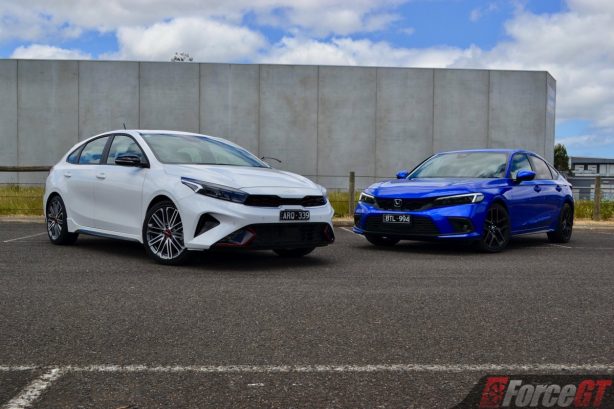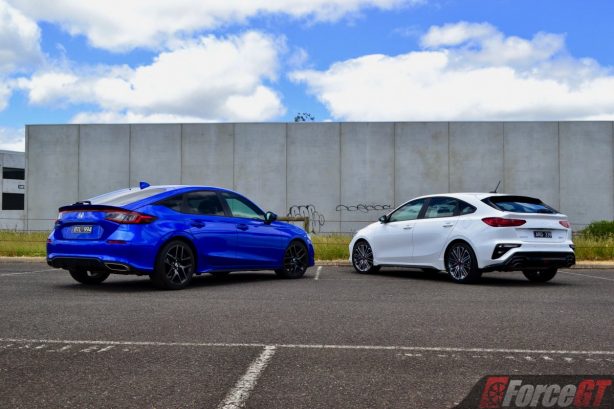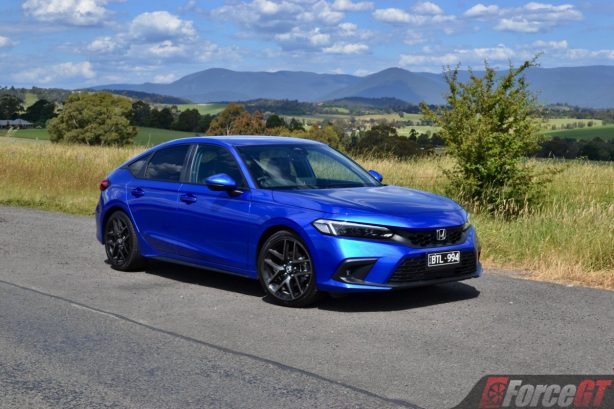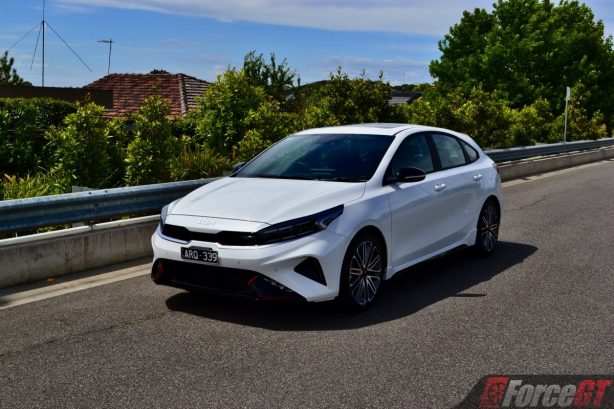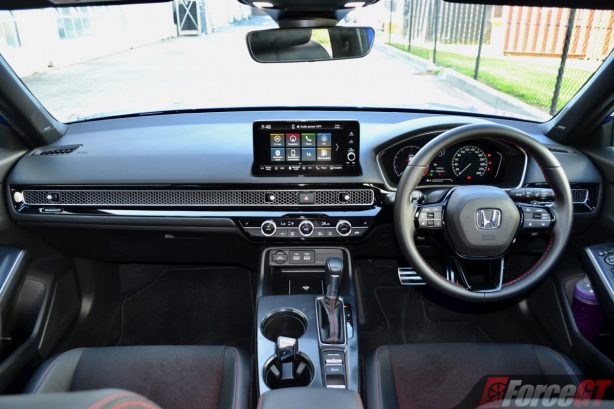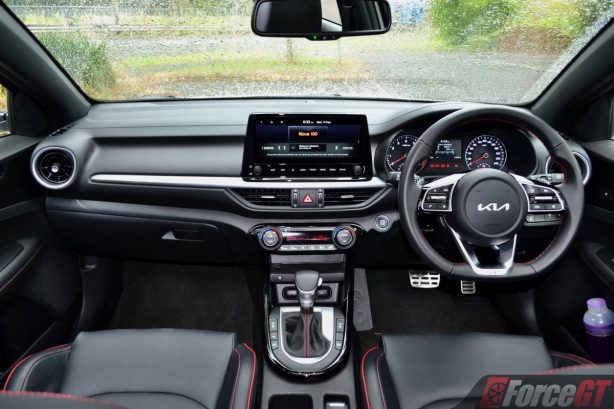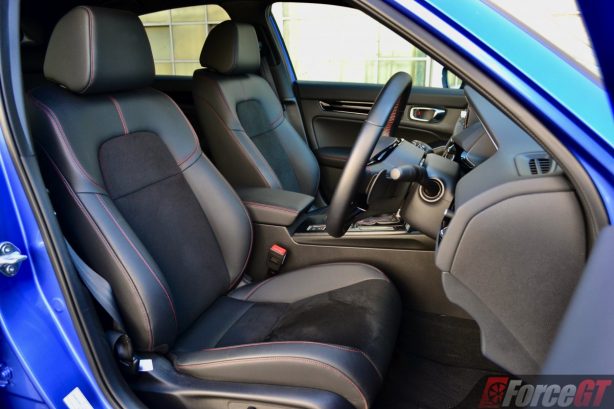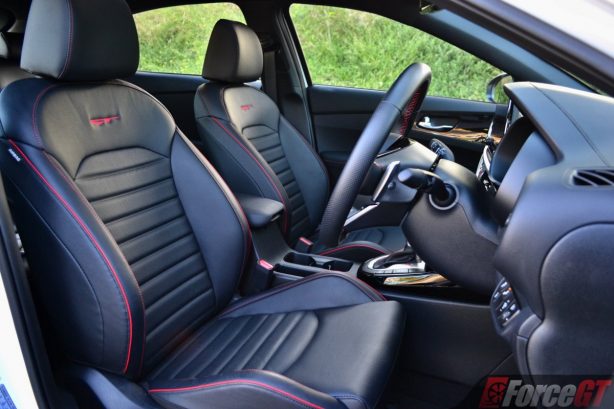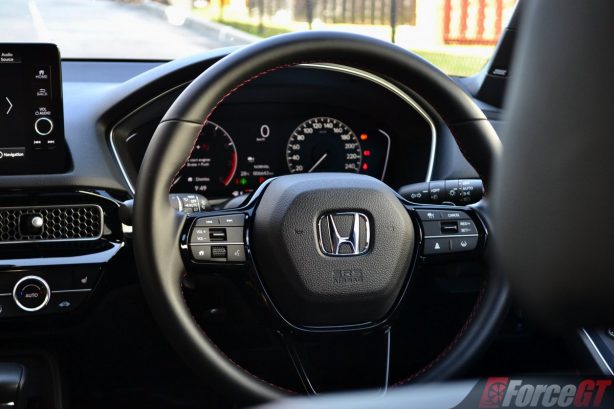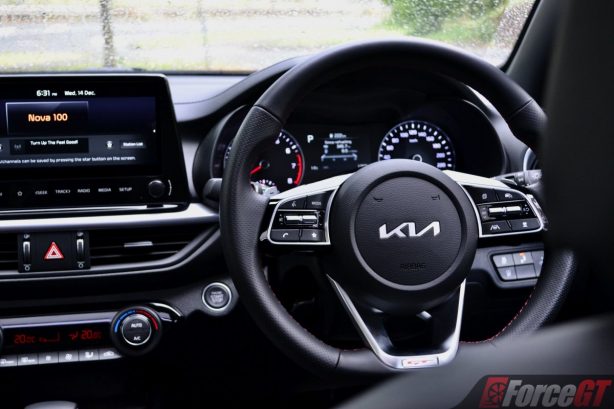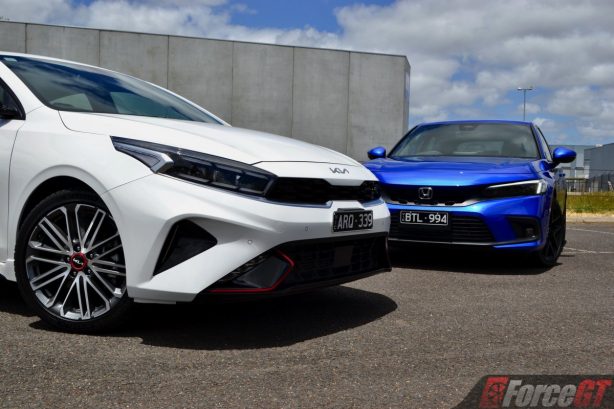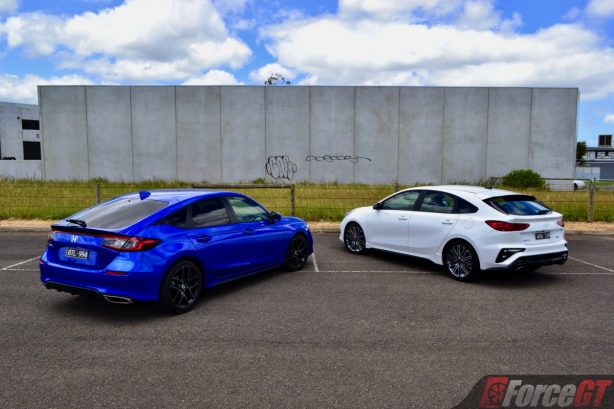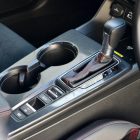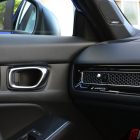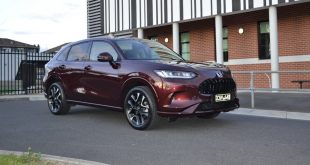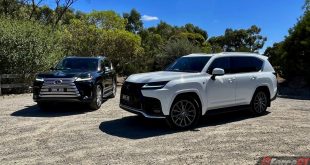Buyers are literally spoilt for choice in the small car segment, with almost every major brand having an entry in this popular category. There’re models geared toward practicality and space, and there’re also models that are a bit sportier. The latter is represented by cars like the Honda Civic hatch and Kia Cerato hatch. Both cars take on a sleeker, more fastback-ish look which stands out amongst the more conventional two-box design seen on other hatches.
While both cars have been lined up here for a comparison test, it’s worth mentioning that the Civic hatch – available in only a single highly spec VTI-LX grade – is the more ‘premium’ option, commanding a drive-away price of $47,200. The Cerato hatch tested here is the range-topping GT variant, yet it costs nearly ten grand less than the Honda, with a drive-away sticker of $38,390.
Exterior
Honda isn’t trying to hide the fact it aims to elevate the Civic into a more upmarket offering, and it’s pairing the high price tag with some classy design elements as well. While looks are subjective, the Civic does come across looking more expensive and sophisticated than the Cerato. The new styling boasts a bolder front fascia characterised by that wider grille which is now positioned lower for a more aggressive look. The shoulder crease stretches uninterrupted from front to back, where it meets the wrapped around taillight. The rear design is a solid effort, too, with the tapered roofline setting off a sporty look. Elsewhere, the five double-spoke 18-inch alloy wheels match well with the car.
In comparison to the Civic, the Cerato’s design is more generic and derivative. That said, it still has some nice details to it, including those blacked out side mirror caps and eye-catching red accents in the grille, around the front bumper intake and on the wheel caps. The brand’s trademark ‘tiger-nose’ grille adds to the sporty looks, while those gloss black lower bumper trims and side skirts set a good contrast to the rest of the body work. Like the Civic, the Cerato rolls on 18-inch allow wheels, albeit with a multi-spoke design.
Interior
Both cars have well presented interiors that befit their high-spec status, although the Civic’s is a bit of an acquired taste. In its quest for simplistic design, Honda has churned up quite a retro styling for the dashboard and that may not sit well with everyone. Granted the honey comb air-con vent design looks unique and overall there’s very little clutter. The gloss black trims are carefully applied to only areas that are unlikely to come in contact with fingers, a clever move to reduce finger prints on such surfaces, while keeping that premium ambiance.
The Cerato’s interior is more uplifting, with polished silver trims punctuating the otherwise black cabin at various places. It’s also sportier with the red stitching found on the steering wheel and seats brighter and more contrasting than that in the Civic. Those round air-con vents also look lovely.
Storage spaces are about equal in both vehicles, with the pair sporting dual cup holders for the front and rear row of seats, centre storage, door pockets with bottle holders and glove box. However, every storage compartment seems to be just slightly larger and better designed in the Civic. The bottle holders in the door pockets for instance, are more usable as they have nothing that gets in the way. We also prefer the round cup holders than the square ones in the Cerato.
The Civic’s practicality winning streak continues in the boot as well, with it boasting a sizeable 449 litres of space, some 21 litres larger than the Cerato’s 428 litres. Not just that, the Honda also has a proper secondary storage tub under the boot floor, while the Kia only has an under floor partitioned tray for extra storage.
While both cars offer good interior space for all occupants, the Civic is slightly ahead in cabin comfort, with the front seats feeling plusher and more cocooning. There’s also a tad more legroom in the back. However, the Civic has a bulkier centre floor hump.
Tech and Safety
In terms of technology and connectivity, essential features such as built-in satellite navigation, Android Auto and Apple CarPlay support, Bluetooth and wireless phone charger are all included in both cars. The Cerato does have a bigger 10.25-inch centre touchscreen, compared to the 9-inch touchscreen in the Civic. Both car’s infotainment systems are intuitive, though the Civic’s larger on-screen buttons are easier to operate on the move.
The Civic’s higher price tag buys you a few niceties that you don’t get in the Cerato, including an instrumentation cluster that combines a customisable 7-inch digital display with a physical speedometer gauge. The Cerato uses a more conventional dual gauge cluster with a centre multi-info display. You also get a quality 11-speaker plus a subwoofer Bose premium audio system in the Honda, versus the Kia’s 8-speaker JBL setup. Neither cars are fitted with head-up display, which isn’t expected in the Kia but certainly is in the higher priced Honda. The lack of a sunroof in the latter is also questionable at this price point.
Both cars are comprehensively equipped when it comes to safety. Adaptive cruise control, autonomous emergency braking, lane departure alert, blind spot monitor, rear-cross traffic alert, reversing camera and vehicle stability control are all standard fitment. The Civic goes a step further by throwing in speed sign recognition and 360-degree surround view camera.
Performance
Powering the Civic is a 1.5-litre turbocharged four-cylinder petrol engine developing 131kW and 240Nm, the latter available from 1700-4500rpm. The engine is paired with a CVT automatic driving the front wheels.
In comparison, the Cerato utilises a slightly larger 1.6-litre turbocharged four-cylinder petrol engine. Rated at 150kW and 265Nm it has more power and torque than the Civic. The torque also arrives earlier at 1500rpm. A 7-speed dual clutch automatic sends power to the front wheels.
While both powertrains have more than enough performance to meet the demands of the daily grind, the feel in which they propel the cars is quite different. The civic delivers a very smooth and polished driving experience, thanks in part to the CVT. Now we know the CVT is often associated with a dull and rubbery driving experience but the one in the Civic is quite the opposite. It’s discrete and quiet under normal driving, yet responsive and direct when you put your foot down. It’s a fine example of a well calibrated CVT.
The Cerato’s drive is more sports biased. The punchier engine combines with the quick shifting dual-clutch auto to deliver a crisp, athletic driving feel. It may not be as refined as the Civic, but its warm hatch-like performance is surely more enjoyable when the road is right.
And it’s not just the powertrain that delivers spices, the firm suspension setup endows the Kia with some genuinely sharp handling as well. That’s not the say the Honda is sappy, far from it. It’s still as competent and dynamic, albeit more refined and less hyper in its responses.
The firmly sprung Cerato only likes smooth roads, as rougher patches and imperfections get transmitted straight to the cabin with little suppression. It’s taking on a bit too much sporting flavour, which is unnecessary for a daily hatch.
The Civic, on the other hand, rides with excellent compliance, with bumps and ruts rounded off nicely. It’s also quieter than the Cerato thanks to better insulation from road and wind noise.
Running Costs
Both cars are inexpensive to fuel, as they chew on regular 91 RON fuel. However, the Civic will also yield more savings at the bowser, averaging just 6.7L/100km at the end of our week-long test, which is not far off the rated 6.3L/100km. The Cerato is inherently thirstier with its larger engine, reporting an average of 8.1L/100km against the rated 6.8L/100km.
There’s also a stark difference in terms of maintenance and warranty. The Civic is backed by a 5-year factory warranty, while the Cerato gives further assurance with a 7-year warranty. Both warranties have no cap on kilometres.
Service requirements are identical for both, at 10,000km or 12 months, but the Civic is a lot cheaper to maintain (surprisingly) with each trip to the dealer capped at $199 for the first five visits. The Cerato’s servicing costs almost double that, at $378 per visit.
Verdict
If you’re in the market for a well equipped daily hatch with sporty looks, both the Civic VTI-LX and Cerato GT are some of your best options. The Cerato, in its top-spec guise tested here, represents good value for what it has to offer, bringing with it athletic performance and a sporty interior. At the other camp, the Civic does cost almost ten big ones more than the Cerato, but it justifies that with a more refined driving feel, upmarket looks, better tech and lower long term running costs.
The Civic is a better car, no doubt. But the Cerato’s value is hard to ignore. For us, we might just stretch the budget a little and go for the Honda.
| 2023 Honda Civic VTi-LX | 2023 Kia Cerato GT | |
| Design and Comfort | 8.5 | 7.0 |
| Performance and Handling | 8.0 | 8.5 |
| Quality | 8.5 | 8.5 |
| Economy | 8.5 | 7.5 |
| Equipment and Features | 8.0 | 8.0 |
| Overall | 42/50 | 40/50 |
Pricing and Specification
| 2023 Honda Civic VTi-LX | 2023 Kia Cerato GT | |
| Price (Driveaway): | $47,200 | $38,390 |
| Warranty: | 5 years, unlimited km | 7 years, unlimited km |
| Warranty Customer Assistance: | N/A | 1 year roadside |
| Service Intervals: | 12 months, 10,000km | 12 months, 10,000km |
| Country of Origin: | Japan | South Korea |
| Engine: | 1.5-litre four-cylinder turbocharged petrol: 131kW @ 6000rpm, 240Nm @ 1700-4500rpm | 1.6-litre four-cylinder turbocharged petrol: 150kW @ 6000rpm, 265Nm @ 1500-4500rpm |
| Transmission: | CVT auto | 7-speed dual clutch auto |
| Drivetrain: | Front-wheel drive | Front-wheel drive |
| Power-to-Weight Ratio (W/kg): | 96.5 | 107.5 |
| Combined Fuel Consumption (L/100km): | Claimed: 6.3/Tested: 6.7 | Claimed: 6.8/Tested: 8.1 |
| Fuel Capacity (L): | 47 | 50 |
| Body: | 5-door hatch, 5-seats | 5-door hatch, 5-seats |
| Safety: | 5-star ANCAP, 7 airbags, ABS, BA, EBD, ESC, Blind-Spot Collision-Avoidance Assist, Forward/Reverse Collision-Avoidance Assist, Lane Keeping Assist, Rear Cross-Traffic Collision-Avoidance Assist, ISOFIX, surround view camera, speed sign recognition | 5-star ANCAP, 6 airbags, ABS, BA, EBD, ESC, Blind-Spot Collision-Avoidance Assist, Forward/Reverse Collision-Avoidance Assist, Lane Keeping Assist, Rear Cross-Traffic Collision-Avoidance Assist, ISOFIX |
| Dimensions (L/W/H/W-B): | 4,560/1,802/1,415/2,735 | 4,510/1,800/1,440/2,700 |
| Kerb Weight (kg): | 1,369 | 1,395 |
| Entertainment: | 9-inch colour touchscreen, satellite navigation, AM/FM/DAB+, Bluetooth, USB, AUX, Apple CarPlay/Android Auto, 11 speakers Bose premium audio | 10.25-inch colour touchscreen, satellite navigation, AM/FM/DAB+, Bluetooth, USB, AUX, Apple CarPlay/Android Auto, 8 speakers JBL audio |
 ForceGT.com Car News, Car Reviews, Video Reviews, Tuning and much more.
ForceGT.com Car News, Car Reviews, Video Reviews, Tuning and much more. 